| Author |
Message |
Alain D.

|
 Posted: Mon 06 Dec, 2010 3:34 pm Post subject: Early Crossbows Posted: Mon 06 Dec, 2010 3:34 pm Post subject: Early Crossbows |
 |
|
It seems like a lot of crossbow discussion focuses on late medieval composite and steel crossbows, but what about earlier ones like the self bow crossbows used by Crusaders? I know these were lighter than the later crossbows due to the lack of spanning devices, but did they have significantly larger prods? It seems like a larger prod could have given even simple self bows incredible power.
I'd be interested to see some contemporary depictions of self crossbows and hear about their battlefield uses and crossbow units before the Hundred Years War if anybody has information on them.
Thanks
-Alain
P.S. I did use the search function, but couldn't find very much on self bows specifically, sorry if the topic has already been covered.
|
|
  |
 |
Jean Thibodeau

|
 Posted: Mon 06 Dec, 2010 4:12 pm Post subject: Re: Early Crossbows Posted: Mon 06 Dec, 2010 4:12 pm Post subject: Re: Early Crossbows |
 |
|
| Alain D. wrote: | It seems like a lot of crossbow discussion focuses on late medieval composite and steel crossbows, but what about earlier ones like the self bow crossbows used by Crusaders? I know these were lighter than the later crossbows due to the lack of spanning devices, but did they have significantly larger prods? It seems like a larger prod could have given even simple self bows incredible power.
I'd be interested to see some contemporary depictions of self crossbows and hear about their battlefield uses and crossbow units before the Hundred Years War if anybody has information on them.
Thanks
-Alain
P.S. I did use the search function, but couldn't find very much on self bows specifically, sorry if the topic has already been covered. |
Design-wise I sort of wonder the same thing as longer bow/prods with longer throw and longer bolts would use the lower draw weights more efficiently than very small prods and short throw lengths one can get away with by the brute force method of very heavy draw weights of the late crossbows.
Compact size may be a factor to a degree but I would have thought that the crossbow makers of the time would at least empirically be aware of these factors even if they would not understand the math involved just by trial and error ?
I have no historical evidence to add to this discussion but I'm also very interested in any answers based on more than speculation like I just submitted.  
You can easily give up your freedom. You have to fight hard to get it back!
|
|
  |
 |
|
Michael S. Rivet
|
 Posted: Mon 06 Dec, 2010 5:15 pm Post subject: Posted: Mon 06 Dec, 2010 5:15 pm Post subject: |
 |
|
The Real Fighting Stuff by Tobias Capwell pictures two crossbows that may be of interest, in that both have, or appear to have, wooden prods. I'm without scanner at the moment, so I can't . . . no, wait. My hard drive to the rescue! I do have pictures.
The first (p15) has what appears to be a single piece of yew for the prod, left knotted and rough. The author speculates, based on the characteristics of the prod, that its manufacture may have been as early as the 14th century.
The second (p25) is later, circa 1480 according to the text.
Aaaaand that's about all the text has to offer.
Anyway, the first may support the idea of a wide prod. Or maybe it's just a really skinny tiller. Both prods are pretty thick, though.
 Attachment: 24.59 KB Attachment: 24.59 KB
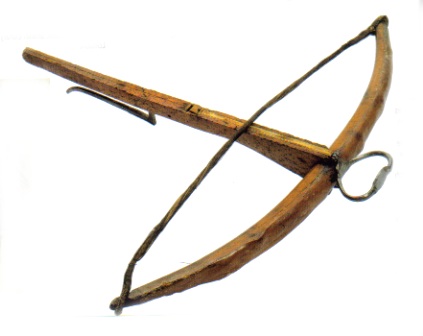
 Attachment: 35.8 KB Attachment: 35.8 KB
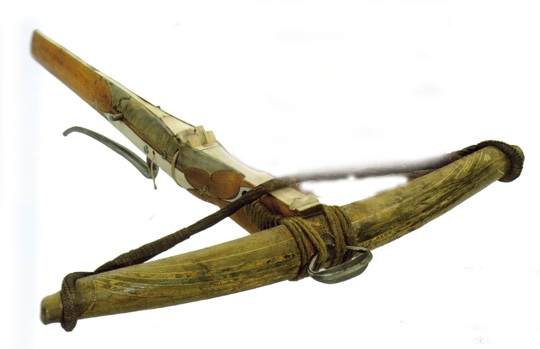
|
|
  |
 |
|
Joel Minturn
|
 Posted: Mon 06 Dec, 2010 5:27 pm Post subject: Posted: Mon 06 Dec, 2010 5:27 pm Post subject: |
 |
|
Towards the end of the 12th century there was a considerable innovation in crossbow design with the addition of the foot stirrup, roller nut and composite prods. By the 13th century crossbows had there classic design. It seems that the crossbows the crusaders were using and bringing to the middle east had composite prods. Though they all seem to have been spanned using foot stirrups of either 1 or 2 foot design and a belt hook.
But to answer the other part of your question. Yes the prods on the earlier self bows were much longer though the draw length doesn't seem to be much bigger. Wood prods will need to be longer than composite or metal prods to deal with the stresses. While no draw weights were listed in Josef Alms book on crossbows the heavier wood crossbows required both feet to span. the feet were placed on the prod on either side of the tiller (body). the bowman grabs the string and then rocks back using the leg muscles to span the bow.
All wood crossbows seem to have been used in Norway to hunt whales for a long time possibly till the late 1800s.
From Josephs Alms "European Crossbows: A survey by Josef Alm"
Norwegian all wood crossbow
Bow 91cm long, 4cm across, 3.5cm thick in the middle
tiller (body) 81cm long
Draw Length 29.5cm
Its not the length of the prod that would make it more efficient but the draw length. While I'm not an expert on crossbows it seems that crossbows traditionally favor raw strength over efficiency.
|
|
  |
 |
Alain D.

|
 Posted: Mon 06 Dec, 2010 6:30 pm Post subject: Posted: Mon 06 Dec, 2010 6:30 pm Post subject: |
 |
|
| Joel Minturn wrote: | It seems that the crossbows the crusaders were using and bringing to the middle east had composite prods. Though they all seem to have been spanned using foot stirrups of either 1 or 2 foot design and a belt hook.
|
I was under the impression that Crusaders adopted the composite bow from the Saracens?
Great posts everyone, thank you
-Alain
|
|
  |
 |
Iagoba Ferreira

|
 Posted: Tue 07 Dec, 2010 3:30 am Post subject: Posted: Tue 07 Dec, 2010 3:30 am Post subject: |
 |
|
I'm interested on this subject, too.
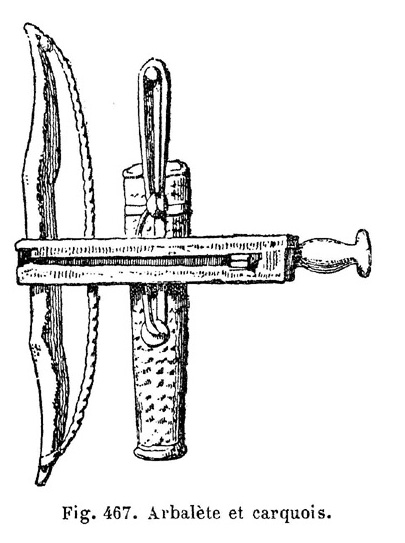
There is a bas-relief from Puy, France, depicting two crossbows in a hunting scene, from the Late Roman empire. A drawing from a XIX century book is the only source, I don't know any modern photographs or drawings on this piece. It seems to have a nut...
Also, some crosbow nuts made from bone have been found in Roman contexts, but I cannot be more precise now on this (give me a couple of days to check it  ) )
|
|
  |
 |
|
Joel Minturn
|
 Posted: Tue 07 Dec, 2010 5:37 am Post subject: Posted: Tue 07 Dec, 2010 5:37 am Post subject: |
 |
|
| Alain D. wrote: |
I was under the impression that Crusaders adopted the composite bow from the Saracens?
Great posts everyone, thank you
-Alain |
I believe that the concept of the composite bow came to Europe from the mongols or some other similar group. Though the European composite crossbow prod was a little different in design than the Asian design. And according to Josef Alm the crusaders brought the crossbow to the middle east. At least during the crusades on the crossbow never became to poplar on the Arab side but was used by them a few times namely in defensive situations.
It quite possible that the Roman and Greek crossbows had a roller nut style lock. I don't believe we have too much information on those really early crossbows. After the collapse of the Roman Empire crossbows lost a lot of the popularity and use they had during the early times so it wouldn't surprise me if innovations like the roller nut were forgotten,
|
|
  |
 |
|
Sam Gordon Campbell
Location: Australia. Joined: 16 Nov 2008
Posts: 678
|
 Posted: Tue 07 Dec, 2010 6:59 am Post subject: Posted: Tue 07 Dec, 2010 6:59 am Post subject: |
 |
|
I think I had a picture at some point of a fesco/mosaic of a Roman who looked alot like Jesus hold a handheld (no stock) crossbow much like the one Iagoba posted...
Anyone else know it?
Member of Australia's Stoccata School of Defence since 2008.
Host of Crash Course HEMA.
Founder of The Van Dieman's Land Stage Gladiators.
|
|
  |
 |
|
Lafayette C Curtis
|
 Posted: Tue 07 Dec, 2010 8:48 am Post subject: Posted: Tue 07 Dec, 2010 8:48 am Post subject: |
 |
|
| Alain D. wrote: | | I was under the impression that Crusaders adopted the composite bow from the Saracens? |
Not necessarily. Islamic principalities of one stripe or another still hung around in Sicily and Italy for quite a while, and sizable Muslim populations lasted even longer under Christian rulers. Some of the instances are described in this article:
http://www.deremilitari.org/resources/article...rchers.htm
In any case, it is much more likely that the adoption of composite prod technology happened through the agency of these Italian Muslims (and ex-Muslims), considering that they already lived quite close to the centres of crossbow production and development in Italy as opposed to the proper Saracens and Turks all the way on the other side of the Mediterranean.
|
|
  |
 |
Elling Polden

|
 Posted: Tue 07 Dec, 2010 8:50 am Post subject: Posted: Tue 07 Dec, 2010 8:50 am Post subject: |
 |
|
Our favourite norwegian source, the Kingsmirror(1250) states that it is "Also a good thing to have a horn-bow or weak crossbow that can be reloaded on horseback"
these would be small crossbows with wooden or horn-reinforced prods.
The idea of horn/wood composite bows where adopted by the romans from the peoples on their eastern frontier, and used by roman archers and cavalry. Frankish manuscripts from the 800s show recurved composite bows; Most likely they fell from use as as the extra performance was not considered worth the extra time to make one, compared with a stick or two-wood composite bow. There are still depictions of static recurves in high medevial manuscripts like Maciowski, though.
"this [fight] looks curious, almost like a game. See, they are looking around them before they fall, to find a dry spot to fall on, or they are falling on their shields. Can you see blood on their cloths and weapons? No. This must be trickery."
-Reidar Sendeman, from King Sverre's Saga, 1201
|
|
    |
 |
Alain D.

|
 Posted: Tue 07 Dec, 2010 5:43 pm Post subject: Posted: Tue 07 Dec, 2010 5:43 pm Post subject: |
 |
|
| Elling Polden wrote: | | Frankish manuscripts from the 800s show recurved composite bows; |
I'd never heard of Franks using composite bows before, but that's very interesting. Do you know where those pictures could be found?
Do we have any evidence of early crossbow draw weights beyond the fact that they lacked the spanning devices found on the later bows?
-Alain
|
|
  |
 |
Elling Polden

|
 Posted: Tue 07 Dec, 2010 6:05 pm Post subject: Posted: Tue 07 Dec, 2010 6:05 pm Post subject: |
 |
|
| Alain D. wrote: |
I'd never heard of Franks using composite bows before, but that's very interesting. Do you know where those pictures could be found?
-Alain |
The bottom post at the first page of this excellent thread, for instance; http://www.myArmoury.com/talk/viewtopic.php?t=9561
"this [fight] looks curious, almost like a game. See, they are looking around them before they fall, to find a dry spot to fall on, or they are falling on their shields. Can you see blood on their cloths and weapons? No. This must be trickery."
-Reidar Sendeman, from King Sverre's Saga, 1201
|
|
    |
 |
Quinn W.

Location: Bellingham, WA Joined: 02 May 2009
Posts: 197
|
 Posted: Wed 08 Dec, 2010 12:20 am Post subject: Posted: Wed 08 Dec, 2010 12:20 am Post subject: |
 |
|
My professor told my in my Medieval Warfare class that the glues in the composite bow didn't hold up as well in western climates because damper air, hence its popularity on the steppes but its general absence in western Europe. If the Franks used them, did they somehow overcome this problem, or were they only used briefly? Or is this initial assumption incorrect?
"Some say that the age of chivalry is past, that the spirit of romance is dead. The age of chivalry is never past, so long as there is a wrong left unredressed on earth"
|
|
   |
 |
Leo Todeschini
Industry Professional

|
 Posted: Wed 08 Dec, 2010 1:17 am Post subject: Posted: Wed 08 Dec, 2010 1:17 am Post subject: |
 |
|
Alain D wrote | Quote: | I know these were lighter than the later crossbows due to the lack of spanning devices, but did they have significantly larger prods? It seems like a larger prod could have given even simple self bows incredible power.
|
I know of only two existing early self wood bows, the Berkhampstead bow at about 1.2m (4') and was probably some sort of rampart bow and the one shown below from Glasgow which is clearly a hand held bow. So really we do not have enough to go on. I have been doing some recent work for a customer with Steve Stratton from DIY archery, who is a great war bow maker and we have struggled to a degree. We have two bows out at present (though more may follow in the next year) one is about 70cm long and the other is 115cm long and they come in at about 90lb/130mm draw (5') and 300lb/175mm (7.5') draw. you will of course get to hear things as we have any news.
Jean Thibodeau wrote | Quote: | Design-wise I sort of wonder the same thing as longer bow/prods with longer throw and longer bolts would use the lower draw weights more efficiently than very small prods and short throw lengths one can get away with by the brute force method of very heavy draw weights of the late crossbows.
|
I don't really understand this either. Historically the Scandinavians seem to use longer draws that the more southerly Europeans, but basically the draws and limb sizes are shorter than you would suspect for efficiency. They just didn't seem to do it, but you can bet they knew it.
Micheal S Rivet wrote | Quote: | | Anyway, the first may support the idea of a wide prod. Or maybe it's just a really skinny tiller. Both prods are pretty thick, though. |
The second bow is a composite for sure and they always show this hugely thick profile. The first bow is on a skinny tiller, but many were to modern eyes (and broke for the price of fashion) but is still a thick brute.
Quinn W wrote | Quote: | | My professor told my in my Medieval Warfare class that the glues in the composite bow didn't hold up as well in western climates because damper air, hence its popularity on the steppes but its general absence in western Europe. If the Franks used them, did they somehow overcome this problem, or were they only used briefly? Or is this initial assumption incorrect? |
Hes is partly right. The glues were not moisture resistant so that a bow left spanned in very wet conditions could delaminate or the internal matrices slip. However natural glues will get tacky and gel as they get damp, but when they dry they will rebond exactly as before. Composite bows are always covered in a moisture (reasonably) impermeable layer such as birch bark or snake skin that holds the core of the bow moisture stable. So if you go on a campaign for 4 weeks in the rain, yes your bow will be unuseable - it simply will not function. If you keep it waxed and dry and warm and string it, shoot it and unstring it as required, it will be fine even in the rain. Note that basically all hunting bows of European origin were composite from at least 1400 through to 1700 and beyond. Most of the late period hunting bows that show steel bows actually have been rebowed from the composite originals.
I guess for a common soldier this makes a steel bow easier by far to look after, but for a rich man with servants and tents a composite bow is just fine and is more efficient.
I am out of my depth here, but I think the the Roman bows were if not composite, then at least the 'ears' were bonded on and these worked just fine in England.
Regards
Tod
www.todsworkshop.com
www.todcutler.com
www.instagram.com/todsworkshop
https://www.facebook.com/TodsWorkshop
www.youtube.com/user/todsstuff1
|
|
   |
 |
Iagoba Ferreira

|
 Posted: Wed 08 Dec, 2010 4:58 am Post subject: Posted: Wed 08 Dec, 2010 4:58 am Post subject: |
 |
|
Related to the use of composite bows (as bow or crosbow bow -I hope that's clear  -) -)
Many Spanish Beatos (silos, Osma, Liebana...)and Bibles (Leon...) from around X-XI centuries show recurved bows. They may be composite:
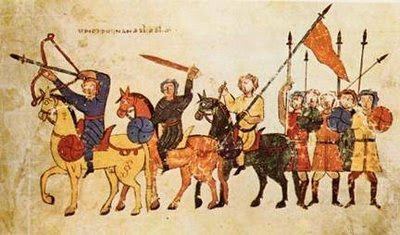


A more explicit Cordobese text from the year 961 explains that in June, the horns of the goats and deer were recollected to make bows. They are frecuent in the Islamic art of the Peninsula (if you don't want to look for it: there is one archer in each corner):
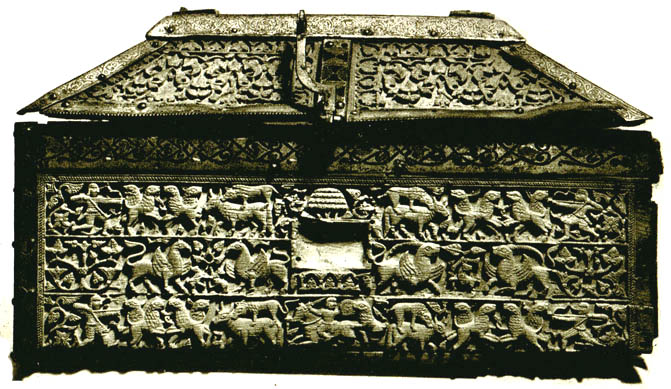
The Liber ad honorem Augusti also shows plenty of them , but it's more "modern" 
From the XII century the bow loses popularity and it's hard to find any mention at all of it: the crossbow was much more popular, and more represented in art.
Going back to the topic (early crossbows) I'd like to share the earliest image of this weapon in the Iberian peninsula (and perhaps of Europe):
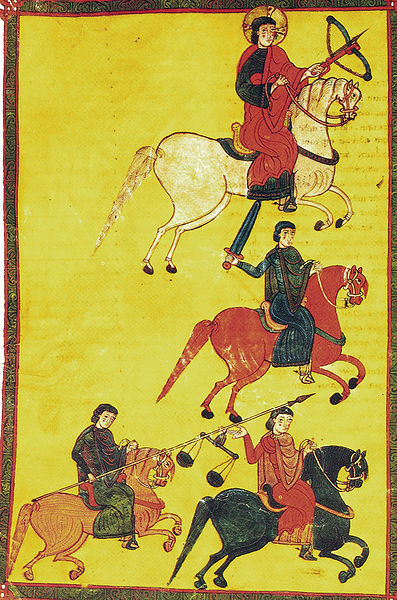
You can see here bigger
That is the "Four Riders" scene from the Beato de Osma, dated in 1085. Perhaps is this one which Sam Gordon Campbell has seen: it is quite simmilar to the Roman one. The white horse rider is the only of the four with a minbus (?). Perhaps that may explain the simmilarity with Jesus (althrough certain interpretations of this book support that this rider is, in fact, Jesus itself).
I hope all this looong post has been of interest 
|
|
  |
 |
|
Danny Grigg
|
 Posted: Fri 10 Dec, 2010 7:20 pm Post subject: Posted: Fri 10 Dec, 2010 7:20 pm Post subject: |
 |
|
| Michael S. Rivet wrote: | The Real Fighting Stuff by Tobias Capwell pictures two crossbows that may be of interest, in that both have, or appear to have, wooden prods. I'm without scanner at the moment, so I can't . . . no, wait. My hard drive to the rescue! I do have pictures.
The first (p15) has what appears to be a single piece of yew for the prod, left knotted and rough. The author speculates, based on the characteristics of the prod, that its manufacture may have been as early as the 14th century.
The second (p25) is later, circa 1480 according to the text.
Aaaaand that's about all the text has to offer.
Anyway, the first may support the idea of a wide prod. Or maybe it's just a really skinny tiller. Both prods are pretty thick, though. |
There's a bit more information about the wooden / yew crossbow here:
http://collections.glasgowmuseums.com/starobj...&img=1
There's also a bunch of reconstructions of early crossbows on the net:
http://paleoplanet69529.yuku.com/topic/11332
http://paleoplanet69529.yuku.com/reply/124553...ssbow.html
http://paleoplanet69529.yuku.com/topic/24909?page=1
http://www.angevin.org/xbow0.htm
http://homepages.tesco.net/~tinyclanger/fitzg...ssbows.htm
http://en.wikipedia.org/wiki/Sk%C3%A5ne_Lockbow
http://www.1186-583.org/IMG/jpg/lt_img_0276_int.jpg
The following site has a great range of reconstructed period arms and armour including an early crossbow. All in german, however it is still a great site:
http://www.historiavivens1300.at/hv1300-e.htm
http://www.historiavivens1300.at/realien/index4.htm
http://www.historiavivens1300.at/realien/armbrust3.htm
Danny
|
|
  |
 |
|
Lafayette C Curtis
|
|
  |
 |
|
Sam Gordon Campbell
Location: Australia. Joined: 16 Nov 2008
Posts: 678
|
 Posted: Tue 14 Dec, 2010 4:13 am Post subject: Posted: Tue 14 Dec, 2010 4:13 am Post subject: |
 |
|
| Iagoba Ferreira wrote: | | ... Perhaps is this one which Sam Gordon Campbell has seen: it is quite simmilar to the Roman one. The white horse rider is the only of the four with a minbus (?). Perhaps that may explain the simmilarity with Jesus (althrough certain interpretations of this book support that this rider is, in fact, Jesus itself)... |
Yes! That's the one I was thinking of!
I was having a debate with a friend over the earliest appearance of 'crossbows', and I kept stating that the earliest 'version' was Greek and that they were even known in the 11thC.
Cheers Iagoba!
Member of Australia's Stoccata School of Defence since 2008.
Host of Crash Course HEMA.
Founder of The Van Dieman's Land Stage Gladiators.
|
|
  |
 |
Alain D.

|
 Posted: Tue 14 Dec, 2010 8:40 am Post subject: Posted: Tue 14 Dec, 2010 8:40 am Post subject: |
 |
|
| Lafayette C Curtis wrote: |
Of course, if Norman and Crusader crossbows could be described as "early crossbows," then Chinese ones ought to be called "bloody early crossbows" out of their sheer antiquity.... |
Haha, yes, any early examples are great, thank you. I was thinking primarily of crossbows between the fall of the Roman Empire and the 13th Century, but I'm also interested in things like the Greek gastraphetes, which is hard to find information about online (at least in my searches).
I also just found an excellent article in Technology and Culture entitled "Crossbows for the King: The Crossbow During the Reigns of John and Henry III of England" about 13th Century crossbows. I wasn't able to upload it due to its size, but you might be able to find it with access to some online article databases.
|
|
  |
 |
|
Lafayette C Curtis
|
 Posted: Wed 22 Dec, 2010 8:48 am Post subject: Posted: Wed 22 Dec, 2010 8:48 am Post subject: |
 |
|
| Alain D. wrote: | | I was thinking primarily of crossbows between the fall of the Roman Empire and the 13th Century, but I'm also interested in things like the Greek gastraphetes, which is hard to find information about online (at least in my searches). |
The gastrophetes/gastraphetes? Hard to find? Seriously! Even Wikipedia has a page on it. It's one of the ancient inventions we only know of from a single source (in this case Heron's Belopoeika), and that single source has pretty much been studied to death. In any case, it doesn't seem that this thread of projectile weapon development led to any sort of handheld crossbow that saw widespread use, which is curious since Syracuse had both the wealth and the population needed to field large crossbow-armed formations had they chosen to go that route. Maybe their preference for using mercenaries (rather than putting their own citizens on the line) made the large-scale adoption of any technical innovation a bit difficult?
In any case, the information we have so far still seems to indicate that the Chinese invented their crossbows independently and earlier by about a century, but there's little evidence to show how quickly the crossbow became a popular personal weapon there and what developments it went through before it arrived at the relatively well-known late Warring States/early Han form. Chinese primary sources aren't much help either since there aren't many that have been translated into English. Now that's what I call "hard to find."
|
|
  |
 |
|
|
You cannot post new topics in this forum
You cannot reply to topics in this forum
You cannot edit your posts in this forum
You cannot delete your posts in this forum
You cannot vote in polls in this forum
You cannot attach files in this forum
You can download files in this forum
|
All contents © Copyright 2003-2025 myArmoury.com — All rights reserved
Discussion forums powered by phpBB © The phpBB Group
Switch to the Basic Low-bandwidth Version of the forum
|

